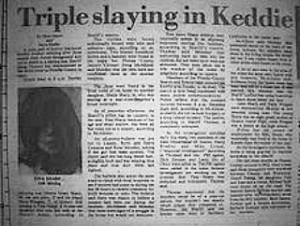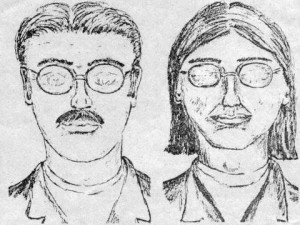On Oct. 24, 2009, two psychics visited Cabin 28 with Sheila Sharp, Sue’s daughter, and family friend, Richard Meeks, who also lived at the Keddie Resort. One of the psychics was a medium who could speak with the dead while the other used EVP.
Working together the result was both fascinating and spooky.
First, they approached the site of Cabin 28, which at this point had been torn down. Trampling through dead leaves, they stepped inside the perimeter of where the cabin once sat. Immediately the medium heard screaming. The lights on the EVP went wild, cherry dots flashing on and off.
The medium was visibly chilled to the bone as she recited the following:
Sue opened the door. “Oh…my…God, I know them.”
Two men enter the cabin with a third standing behind them. “No. Please. Don’t!”
Screaming, pain, pleading, begging.
“There were two. And a third. You’re on the right track [in the investigation], but what about Dee? Find Dee.”
“No! Not my babies, please! Kill me, just let them go.”
Unbearable pain. Chaos.
The medium tries to calm her.
Sue refuses to leave the site until all have been punished. Tortured and murdered, preferably. “Why isn’t anyone punishing them?”
Sheila Sharp approaches the medium. If you recall from part I, Sheila discovered the bodies.
Sue screams, “No! Baby, please leave and don’t come back.” This is caught on an EVP recording.
The medium again tries to calm Sue enough to speak with her daughter, who is shaking and crying, praying hands in front of her mouth.
Sue finally agrees, but will only say, “Baby, I love you very much. Please promise me you won’t come here anymore. The kids are safe with me. They’re fine. Tina’s with me too. I will protect them. No one better speak their names. And no one can speak to them. You need to leave, baby. If you want to talk to me, you don’t need to come here. Please go. Go!”
The medium asks Sheila if she knows whose cabin that is that Sue keeps pointing at.
Sue screams, “No! Don’t ask her.”
They hurry Sheila away.
Because of Sue’s obvious guilt over opening the door that night and her anger about the situation, the two psychics leave her alone and head toward the cabin Sue’s enraged about.
They enter the cabin, which is still standing.
The EVP goes crazy.
And here’s where we discover the truth from that fateful night.
Bo’s spirit is in the cabin. He’s stuck. Guilt won’t allow him to move on.
The cabin belonged to Martin Smartt.
The medium asks the following:
Are you guilty?
“Yes.”
Do you know what happened?
“Yes.”
Do you want to say something about that night?
“Yes. Wasn’t my idea. Anger around Sue.”
You know Sue?
“Yes.”
Are you stuck here because of what happened?
“Yes. It’s not my fault. Tell her [Sue] I’m sorry. It’s Martin’s fault. And Dee’s. He’s still alive and knows what happened.”
EVP continues to go wild.
“It got outta hand. Didn’t mean where it went. Violence and sex, that’s all we wanted. Wasn’t supposed to go that way.”
Were the boys there, or did they come home?
“Already there.”
Did Sue open the door?
“Yes. Martin pushed past her. Martin said she was easy. But then it got out of control. Martin was enraged, like he was possessed. He took it out on Sue. Sue didn’t matter. Pure animalistic savagery.”
Were there drugs involved?
“No. Drinking.”
Were all three of you involved in the murders?
“Two. I stayed back.”
Here’s my take on the case…
I haven’t been able to determine who “Dee” is, but the family members seem to know him. As soon as the medium related the name they all nodded, confirming the name, so he must be a friend of Martin and Bo.
On the night of April 11, 1981 or early morning hours of April 12th, Sue heard a knock at the front door. When she opened it, Martin and Dee pushed their way inside.
They wanted sex. If they had to rape Sue to get it, so be it.
Sue resisted. She screamed, threatened to tell Martin’s wife.
This enraged Martin. He beat her, punched, and kicked her.
His rage increased and the situation escalated. He grabbed the claw hammer, but that wasn’t enough. He drew a blade from his pocket and stabbed her repeatedly. Sue ran at one point because her bloody handprint was on the wall. Streaked, as if she was pushed. Martin or Dee subdued her. Martin delivered the fatal blow.
John heard the commotion and bolted in the living room with his friend, Dana.
Dee lunged at them, aided by Bo. They had to quiet them. They were in too deep to turn back now.
Martin was still busy with Sue. The crime scene showed major overkill. Then he “helped” his buddies with John and Dana.
The cabin exploded in chaos.
Deafening screams of terror.
Justin, Martin’s stepson, awoke in the back bedroom and tiptoed to the archway of the living room. With his back against the wall, he craned his neck around the side of the archway, peeking into the living room. There, he witnessed his stepfather covered in blood, straddling either John or Dana. Without a sound Justin padded to the bedroom and buried his head with his pillow.
Tina awoke, but instead of spying on the men, she entered the living room.
Three dead bodies on the floor. Three men in blood-soaked clothes.
Martin came for sex and he’d be damned if he was leaving without it. He tossed Tina over his shoulder and escaped out the back door. Dee followed close behind.
As Bo viewed the carnage, guilt consumed every inch of him. He covered Sue’s body with a blanket and fled.
Miles away, the three men stopped. Martin either acted alone or the three men gang-raped twelve-year-old Tina. I have no doubt Martin was the one who murdered her to silence her screams, and then disposed of her as if she was yesterday’s trash.
Whether animals tore Tina’s body apart or Martin did it in a fit of rage, I don’t know. We might never know unless the authorities arrest Dee, the only one of the three who’s still alive today.
Years later, Tina’s skull was found near the waterfall, the rest of her remains scattered in the same vicinity.
What’s your view of how the murders occurred?
There are so many angles to this story. A mob connection. A cover-up by the police. I’ll visit this case again in the future. For now, this is where the series ends.






